PLANETS & GODS (2019-) by Mint XXI
What happens when you combine two popular coin themes into one? You get something like Mint XXI’s ‘Planets & Gods’ series of three ounce silver coins. Mixing together the popular ancient mythology and the astronomy genres, they’ve produced an attractive and clever range of coins linking together the planets of our Solar System, with the ancient gods that gave them their names.
Launching in 2019 with Mercury, each coin features a representation of the ancient god, usually in the style of a statue of the period, overlaid on a coloured background image of the planet. The latter has been made possible by the quite extraordinary images sent back by several satellites sent out from Earth over the last few decades. The level of detail we now have of planetary surfaces throughout the system is a source of wonder, a riot of colour and dynamism.
All of the planets, with the exception of Earth, are named after ancient gods, mostly Roman, so sources of sculptural art from antiquity are widespread and varied. You have to give credit to Mint XXI for seeing the potential here, and for realising it so well. Each coin is antique-finished, which shows on the obverse and on the depiction of the god on the reverse, which is struck to a high level of relief. The background is a richly coloured and textured view of the planet.
At the time of writing, all seven coins have been released, which covers all of the planetary bodies strictly defined as full planets, Pluto having recently been reclassified as a ‘Dwarf Planet’ because of its size, and Earth having no defined god to represent it. We’d still like to see Pluto get a coin, and many of the largest moon are likewise named after gods (Ganymede, Calllisto, Io, Europa, etc.), so perhaps a smaller sized and more affordable coin series for them.
2019 MERCURY
Mercurius was the Roman god of commerce, often serving as a mediator between the gods and mortals, his winged feet giving him the advantage of speed, and so was the patron of circulation in general – of people, goods and messages. Mercury protected both merchants and travelers. Mercury was the son of the king of the gods Jupiter and purportedly Maia, goddess of the plains. He is often associated with his Greek counterpart Hermes. His Roman name Mercurius is probably derived from the Latin word for merchandise (merx).
The god is frequently depicted holding the caduceus, a wand used to reconcile conflicts, and winged sandals for quickly carrying messages for the gods. The wand had been given to him by Apollo in Greek mythology. Besides the wand and sandals, he also wore a broad-brimmed hat, the Perasus, and carried a purse, a symbol of his duties as the god of commerce and profits. (Wasson, Donald L. “Mercury (Deity).” Ancient History Encyclopedia. Ancient History Encyclopedia, 06 Nov 2018. Web. 02 May 2019. )
Mercury is the smallest planet in the Solar System and the one closest to the Sun, with an orbital period of about 88 Earth days, which is much faster than any other planet in the Solar System. Seen from Earth, it appears to move around its orbit in about 116 days. It has no known natural satellites. It is named after the Roman deity Mercury, the messenger to the gods.
Partly because it has almost no atmosphere to retain heat, Mercury’s surface temperature varies diurnally more than any other planet in the Solar System, ranging from −173 °C at night to 427 °C during the day in some equatorial regions. The poles are constantly below −93 °C. Mercury’s axis has the smallest tilt of any of the Solar System’s planets (about 1⁄30 of a degree). However, Mercury’s orbital eccentricity is the largest of all known planets in the Solar System. At aphelion, Mercury is about 1.5 times as far from the Sun as it is at perihelion. Mercury’s surface is heavily cratered and similar in appearance to the Moon, indicating that it has been geologically inactive for billions of years.(Source: Wikipedia)
2021 VENUS
Venus is a Roman goddess, whose functions encompassed love, beauty, desire, sex, fertility, prosperity, and victory. In Roman mythology, she was the ancestor of the Roman people through her son, Aeneas, who survived the fall of Troy and fled to Italy. Julius Caesar claimed her as his ancestor. Venus was central to many religious festivals, and was revered in Roman religion under numerous cult titles.
The Romans adapted the myths and iconography of her Greek counterpart Aphrodite for Roman art and Latin literature. In the later classical tradition of the West, Venus became one of the most widely referenced deities of Greco-Roman mythology as the embodiment of love and sexuality. She is usually depicted nude in paintings.
As the brightest natural object in Earth’s night sky after the Moon, Venus can cast shadows and can be, on rare occasions, visible to the naked eye in broad daylight. Venus orbits the Sun every 224.7 Earth days. It takes longer to rotate about its axis than any other planet in the Solar System, and does so in the opposite direction to all but Uranus. This means the Sun rises in the west and sets in the east. Venus does not have any moons, a distinction it shares only with Mercury among the planets in the Solar System.
Venus is a terrestrial planet and is sometimes called Earth’s “sister planet” because of their similar size, mass, proximity to the Sun, and bulk composition. It is radically different from Earth in other respects. It has the densest atmosphere of the four terrestrial planets, consisting of more than 96% carbon dioxide. The atmospheric pressure at the planet’s surface is about 92 times the sea level pressure of Earth, or roughly the pressure at 900 m underwater on Earth. Even though Mercury is closer to the Sun, Venus has the hottest surface of any planet in the Solar System, with a mean temperature of 464 °C. (Wikipedia)
2020 MARS
In ancient Roman religion and myth, Mars was the god of war and also an agricultural guardian, a combination characteristic of early Rome. He was the son of Jupiter and Juno, and the most prominent of the military gods in the religion of the Roman army. Most of his festivals were held in March, the month named for him (Latin Martius), and in October, which began the season for military campaigning and ended the season for farming.
Under the influence of Greek culture, Mars was identified with the Greek god Ares, whose myths were reinterpreted in Roman literature and art. But the character and dignity of Mars differed in fundamental ways from that of his Greek counterpart, who is often treated with contempt and revulsion in Greek literature. Mars’s altar in the Campus Martius, the area of Rome that took its name from him, was supposed to have been dedicated by Numa, the peace-loving semi-legendary second king of Rome. Although Ares was viewed primarily as a destructive and destabilizing force, Mars represented military power as a way to secure peace, and was a father (pater) of the Roman people.
Mars is the second-smallest planet in the Solar System after Mercury and is the fourth farthest away from the Sun. Named after the Roman god of war, it gets its nickname, ‘The Red Planet’ due to its colour, brought about by the presence of iron oxide. Mars is approximately half the diameter of Earth with a surface area only slightly less than the total area of Earth’s dry land. The planet is less dense than Earth, having about 15% of Earth’s volume and 11% of
Earth’s mass, resulting in about 38% of Earth’s surface gravity.
The surface topography is much like an amalgamation of Earth and lunar features, having valleys, deserts, and polar ice caps like the former and plenty of impact craters like the latter. Mars is the site of Olympus Mons, the largest volcano and second-highest known mountain in the Solar System, and of Valles Marineris, one of the largest canyons in the Solar System. The smooth Borealis basin in the northern hemisphere covers 40% of the planet and may be a giant impact feature. Mars has two moons, Phobos and Deimos, which are small and irregularly shaped. These may be captured asteroids, similar to 5261 Eureka, a Mars trojan. (source: Wikipedia)
2021 JUPITER
Jupiter is the god of the sky and thunder and king of the gods in ancient Roman religion and mythology. Jupiter was the chief deity of Roman state religion throughout the Republican and Imperial eras, until Christianity became the dominant religion. In Roman mythology, he negotiates with Numa Pompilius, the second king of Rome, to establish principles of Roman religion such as offering, or sacrifice.
Jupiter is usually thought to have originated as a sky god. His identifying implement is the thunderbolt and his primary sacred animal is the eagle, which held precedence over other birds in the taking of auspices and became one of the most common symbols of the Roman army. The two emblems were often combined to represent the god in the form of an eagle holding in its claws a thunderbolt, frequently seen on Greek and Roman coins. As the sky-god, he was a divine witness to oaths, the sacred trust on which justice and good government depend.
Jupiter is the fifth planet from the Sun and the largest in the Solar System. It is a gas giant with a mass more than 2.5 times that of all the other planets combined, but slightly less than 1% the mass of the Sun. Jupiter is the third-brightest natural object in the Earth’s night sky after the Moon and Venus. It has been observed since pre-historic times and is named after the Roman god Jupiter, the king of the gods.
Jupiter is primarily composed of hydrogen and helium. It likely has a rocky core of heavier elements, but like the other giant planets, Jupiter lacks a well-defined solid surface. The outer atmosphere is visibly segregated into several bands at different latitudes, with turbulence and storms along their interacting boundaries. A prominent result of this is the Great Red Spot, a giant storm that is known to have existed since at least the 17th century, when it was first seen by telescope.
Surrounding Jupiter is a faint planetary ring system and a powerful magnetosphere. Jupiter has 80 known moons and possibly many more, including the four large Galilean moons discovered by Galileo Galilei in 1610. Ganymede, the largest of these, has a diameter greater than that of the planet Mercury. (Source: Wikipedia)
2021 SATURN
Saturn was a god in ancient Roman religion and described as a god of generation, dissolution, plenty, wealth, agriculture, periodic renewal and liberation. Saturn’s mythological reign was depicted as a Golden Age of plenty and peace. After the Roman conquest of Greece, he was conflated with the Greek Titan Cronus. Saturn’s consort was his sister Ops, with whom he fathered Jupiter, Neptune, Pluto, Juno, Ceres and Vesta.
Saturn was especially celebrated during the festival of Saturnalia each December, perhaps the most famous of the Roman festivals, a time of feasting, role reversals, free speech, gift-giving and revelry. The Temple of Saturn in the Roman Forum housed the state treasury and archives (aerarium) of the Roman Republic and the early Roman Empire. The planet Saturn and the day of the week Saturday are both named after and were associated with him.
Saturn is the second-largest in the Solar System, after Jupiter. It is a gas giant with an average radius of about nine and a half times that of Earth. Saturn is named after the Roman god of wealth and agriculture; its astronomical symbol (♄) represents the god’s sickle. The Romans named the seventh day of the week Saturday, Sāturni diēs (“Saturn’s Day”) no later than the 2nd century for the planet Saturn.
Saturn’s interior is most likely composed of a core of iron–nickel and rock. Its core is surrounded by a deep layer of metallic hydrogen, an intermediate layer of liquid hydrogen and liquid helium, and finally a gaseous outer layer. Saturn has a pale yellow hue due to ammonia crystals in its upper atmosphere. Wind speeds on Saturn can reach 1,800 km/h, higher than on Jupiter but not as high as on Neptune.
The planet’s most famous feature is its prominent ring system, composed mostly of ice particles, with a smaller amount of rocky debris and dust. At least 82 moons are known to orbit Saturn, this does not include the hundreds of moonlets in its rings. Titan, Saturn’s largest moon and the second largest in the Solar System, is larger than the planet Mercury, although less massive, and is the only moon in the Solar System to have a substantial atmosphere. (Source: Wikipedia)
2020 URANUS
Uranus was the primal Greek god personifying the sky and one of the Greek primordial deities. Uranus is associated with the Roman god Caelus.] In Ancient Greek literature, Uranus or Father Sky was the son and husband of Gaia, the primordial Earth Mother (Mother Earth). According to Hesiod’s Theogony, Uranus was conceived by Gaia alone, but other sources suggest he was born from Nyx, or Aether and Hemera. Uranus and Gaia were the parents of the first generation of Titans, and the ancestors of most of the Greek gods, but no cult addressed directly to Uranus survived into Classical times, and Uranus does not appear among the usual themes of Greek painted pottery. Elemental Earth, Sky, and Styx might be joined, however, in solemn invocation in Homeric epic.
According to Hesiod’s Theogony, Uranus mated with Gaia, and she gave birth to the twelve Titans: Oceanus, Coeus, Crius, Hyperion, Iapetus, Theia, Rhea, Themis, Mnemosyne, Phoebe, Tethys and Cronus; the Cyclopes: Brontes, Steropes and Arges; and the Hecatoncheires (“Hundred-Handed Ones”): Cottus, Briareus, and Gyges.
Uranus has the third-largest planetary radius and fourth-largest planetary mass in the Solar System. It’s similar in composition to Neptune, which differ from that of the larger gas giants Jupiter and Saturn, sso cientists classify Uranus and Neptune as “ice giants”. Uranus’s atmosphere is similar to Jupiter’s and Saturn’s in its primary composition of hydrogen and helium, but contains more “ices” such as water, ammonia, and methane. It is the coldest planetary atmosphere in the Solar System, with a minimum temperature of -224 °C, and has a complex, layered cloud structure with water thought to make up the lowest clouds and methane the uppermost layer of clouds. The interior of Uranus is mainly composed of ices and rock.
Like the other giant planets, Uranus has a ring system, a magnetosphere, and numerous moons. The Uranian is unique among the planets because its axis of rotation is tilted sideways. Its north and south poles, therefore, lie where most other planets have their equators. In 1986, images from Voyager 2 showed Uranus as an almost featureless planet in visible light. Wind speeds can reach 900 km/h. Uranus is the only planet whose name is derived directly from a figure from Greek mythology, from the Latinised version of the Greek god of the sky Ouranos. (source: Wikipedia)
2021 NEPTUNE
Neptune is the god of freshwater and the sea in Roman religion. He is the counterpart of the Greek god Poseidon. In the Greek-influenced tradition, Neptune is the brother of Jupiter and Pluto; the brothers preside over the realms of Heaven, the earthly world, and the Underworld. Salacia is his wife.
Depictions of Neptune in Roman mosaics, especially those of North Africa, are influenced by Hellenistic conventions. Neptune was likely associated with fresh water springs before the sea. Like Poseidon, Neptune was worshipped by the Romans also as a god of horses, under the name Neptunus Equester, a patron of horse-racing.
Neptune is the farthest known planet from the Sun, the 4th-largest by diameter, the 3rd-most-massive, and the densest giant planet. It is 17 times the mass of Earth. The planet orbits the Sun every 164.8 years at an average distance of 30.1 AU (4.5 billion km). It is named after the Roman god of the sea and has the astronomical symbol ♆, a stylised version of the god Neptune’s trident. Neptune is not visible to the unaided eye and is the only planet in the Solar System found by mathematical prediction rather than by empirical observation. Its largest moon, Triton, was discovered shortly thereafter, though none of the planet’s remaining 13 known moons were located telescopically until the 20th century.
Neptune’s atmosphere is also composed primarily of hydrogen and helium, though it contains a higher proportion of “ices” such as water, ammonia and methane. Its interior is primarily composed of ices and rock. Traces of methane in the outermost regions in part account for the planet’s blue appearance. Neptune’s atmosphere has active and visible weather patterns driven by the strongest sustained winds of any planet in the Solar System, as high as 2,100 km/h. Because of its great distance from the Sun, Neptune’s outer atmosphere is one of the coldest places in the Solar System, with temperatures at its cloud tops approaching −218 °C. Temperatures at the planet’s centre are approximately 5,100 °C. Neptune has a faint and fragmented ring system which was discovered in 1984, then later confirmed by Voyager 2. (Source: Wikipedia)
2022 MOON
As with all the planets, our moon also had a representative deity, and in the case of the Greeks, it was Selene. Born of the Titans Hyperion and Theia, she was sister to the Sun god Helios, and the goddess of the dawn, Eos. She was said to drive her chariot across the heavens, and has more than fifty children, almost all of them daughters.
Her Roman counterpart was called Luna, often depicted as the female complement of Sol. Both were considered by the Romans to be ‘visible’ gods, for the obvious reasons, in contrast to those like Uranus, who were invisible, again, for obvious reasons. Luna is often depicted driving a two-yoke chariot called a biga, drawn by horses or oxen. In Roman art, the charioteer Luna is regularly paired with the Sun driving a four-horse chariot (quadriga).(Source: Wikipedia)
The Earth’s only natural satellite, the moon, is the largest in the solar system relative to the planet it orbits. The second densest after Jupiter’s Io, it’s thought to have formed just after the Earth around 4.5 billion years ago from an impact between a Mars-sized body and the Earth itself.
Set in synchronous rotation with the Earth, always showing its same face, the moon’s gravitational influence produces the ocean tides and is arguably a huge factor in the appearance of life on our planet. The Moon’s current orbital distance is about thirty times the diameter of Earth, causing it to have an apparent size in the sky almost the same as that of the Sun. This allows the Moon to cover the Sun nearly precisely in total solar eclipse. This matching of apparent visual size is a coincidence.
One of the major geologic processes that has affected the Moon’s surface is impact cratering, with craters formed when asteroids and comets collide with the lunar surface. There are estimated to be roughly 300,000 craters wider than 1 km on the Moon’s near side alone. Obviously, this leaves plenty of debris and when a new object impacts the lunar surface, some of that debris is ejected back into space. Occasionally, it lands on Earth.
2022 EARTH
There are many personifications of Mother Earth throughout the world’s religions, but as this series concentrates on the Greco-Roman world, it depicts Gaia/Terra. Gaia is one of the Greek primordial deities, and the ancestral mother of all life. She was the mother of Uranus (who she mated with to create the Titans, Cyclopes, and Giants), and Pontus (who she mated with to create the primordial sea gods). Would make quite the sitcom today!
Terra was her Roman equivalent, one of the 20 primal Roman gods of antiquity. She was often depicted with flowers or fruit, much like in the coin, but usually waist high emerging from a hole in the ground. The seated position on the coin is more Greek in design, so it can be postulated that this design is a good mix of both Greek and Roman interpretations of the Earth goddess.
Earth is the third planet from the Sun and the only astronomical object known to harbour life. While large amounts of water can be found throughout the Solar System, only Earth sustains liquid surface water. About 71% of Earth’s surface is made up of the ocean, dwarfing Earth’s polar ice, lakes, and rivers. Earth’s surface layer is formed of several slowly moving tectonic plates, interacting to produce mountain ranges, volcanoes, and earthquakes. Earth’s liquid outer core generates the magnetic field that shapes Earth’s magnetosphere, deflecting destructive solar winds.
Earth’s atmosphere consists mostly of nitrogen and oxygen. A region’s climate is governed by latitude, but also by elevation and proximity to moderating oceans. Severe weather, such as tropical cyclones, thunderstorms, and heatwaves, occurs in most areas and greatly impacts life. Earth formed over 4.5 billion years ago.
Earth is an ellipsoid with a circumference of about 40,000 km, and is the densest planet in the Solar System. Of the four rocky planets, it is the largest and most massive. Earth is about eight light minutes away from the Sun and orbits it, taking a year (about 365.25 days) to complete one revolution. Earth rotates around its own axis in just less than a day (in about 23 hours and 56 minutes). Earth’s axis of rotation is tilted with respect to the perpendicular to its orbital plane around the Sun, producing seasons. Earth is orbited by one permanent natural satellite, the Moon, which orbits Earth at 380,000 km (1.3 light seconds) and is roughly a quarter as wide as Earth. The Moon always faces the Earth with the same side through tidal locking and causes tides, stabilizes Earth’s axis, and gradually slows its rotation. (Source: Wikipedia)
PACKAGING & OBVERSE
Issued for Cameroon, this one has gone with the effigy of Queen Elizabeth II rather than the national emblem, which does sit underneath her in miniature form. All of the inscribed details are restricted to a border on this face, keeping them away from spoiling the reverse design.
Packaging is neat and classy, if a little generic, with a white-lined grey ‘snapper’ box. There’s a Certificate of Authenticity included.
SPECIFICATION
| PLANETS & GODS SERIES | |
| DENOMINATION | 3,000 Francs CFA (Cameroon) |
| COMPOSITION | 0.999 silver |
| WEIGHT | 93.3 grams |
| DIMENSIONS | 55.00 mm |
| FINISH | Antique |
| MODIFICATIONS | High-relief, Colour |
| MINTAGE | 500 per design |
| BOX / C.O.A. | Yes / Yes |


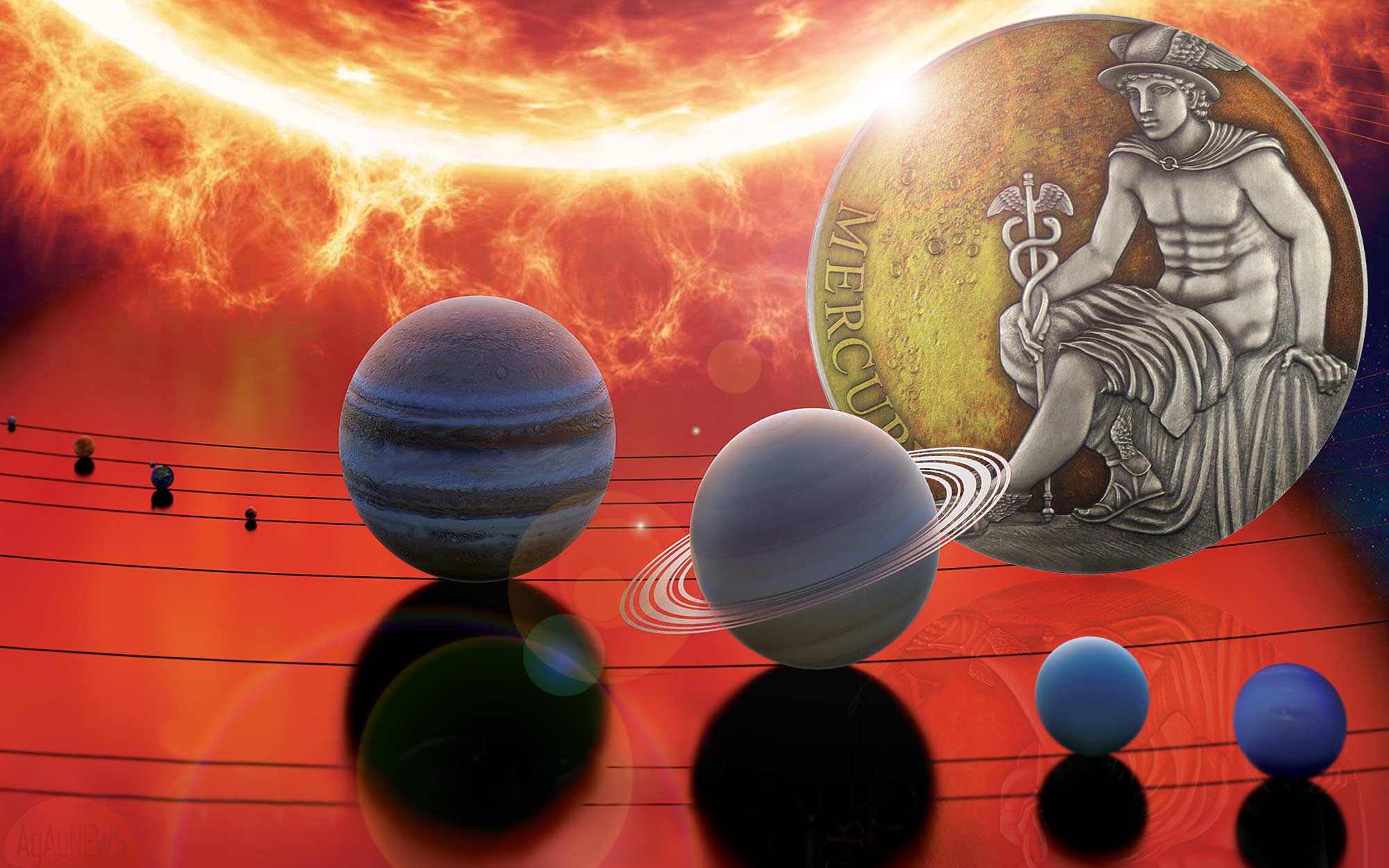
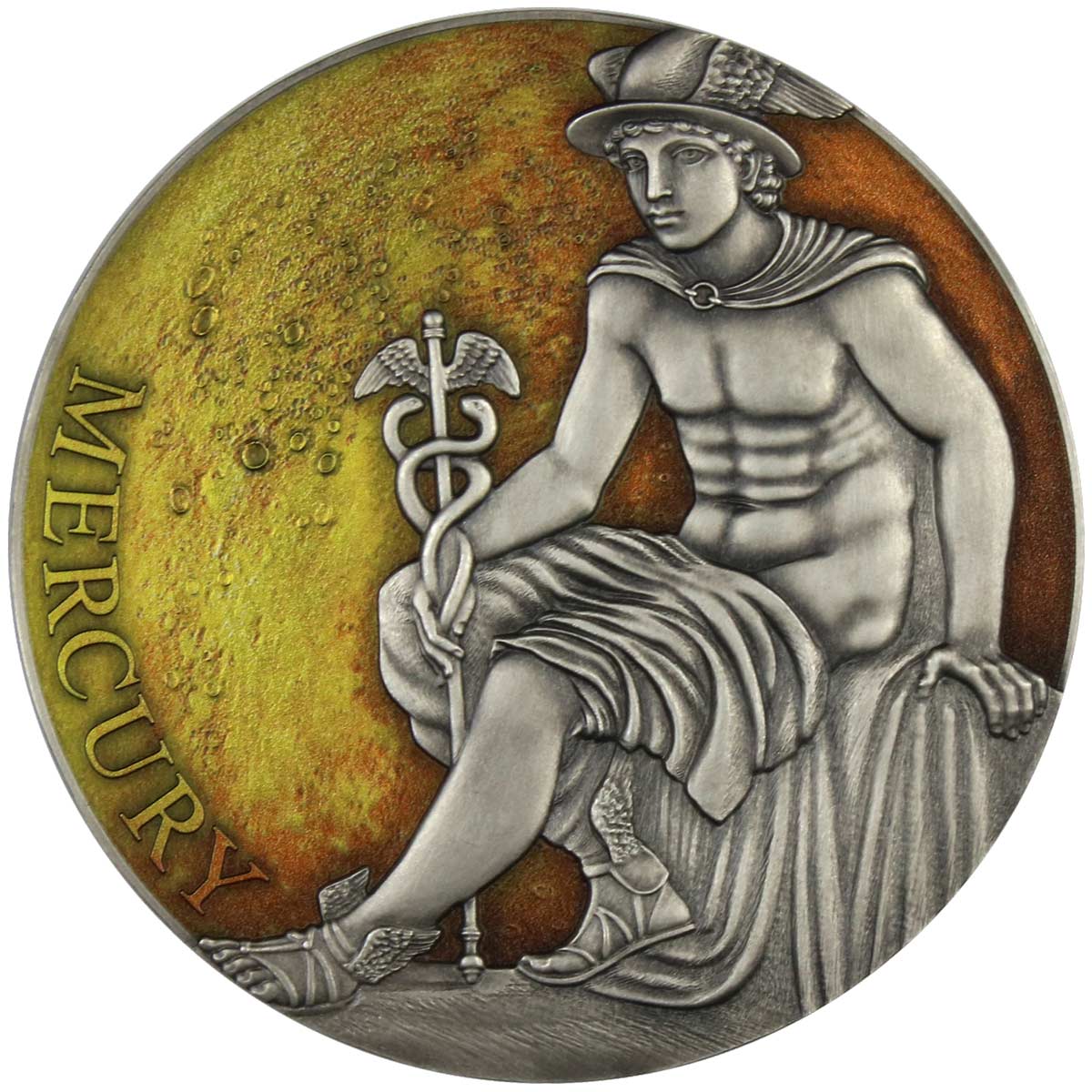
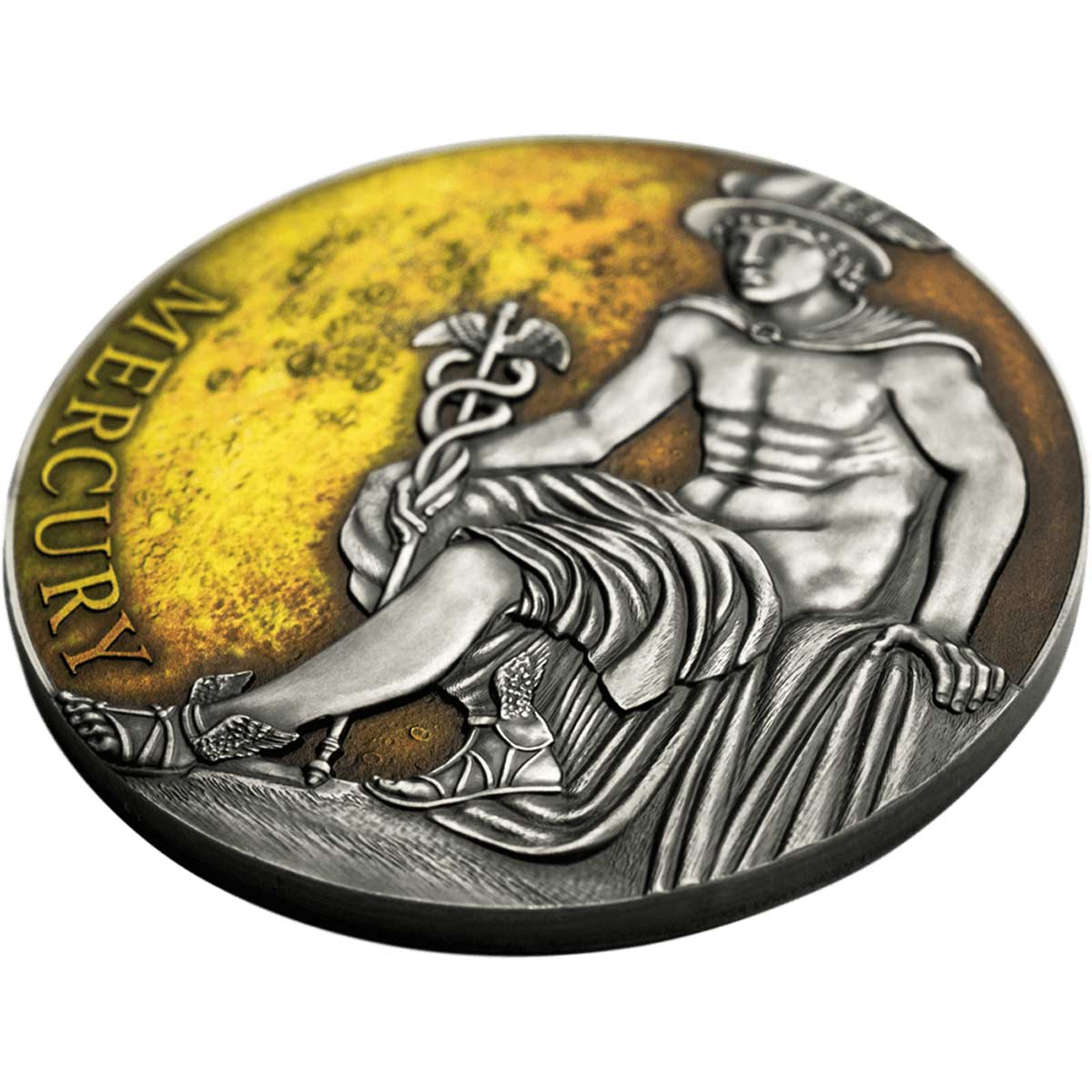



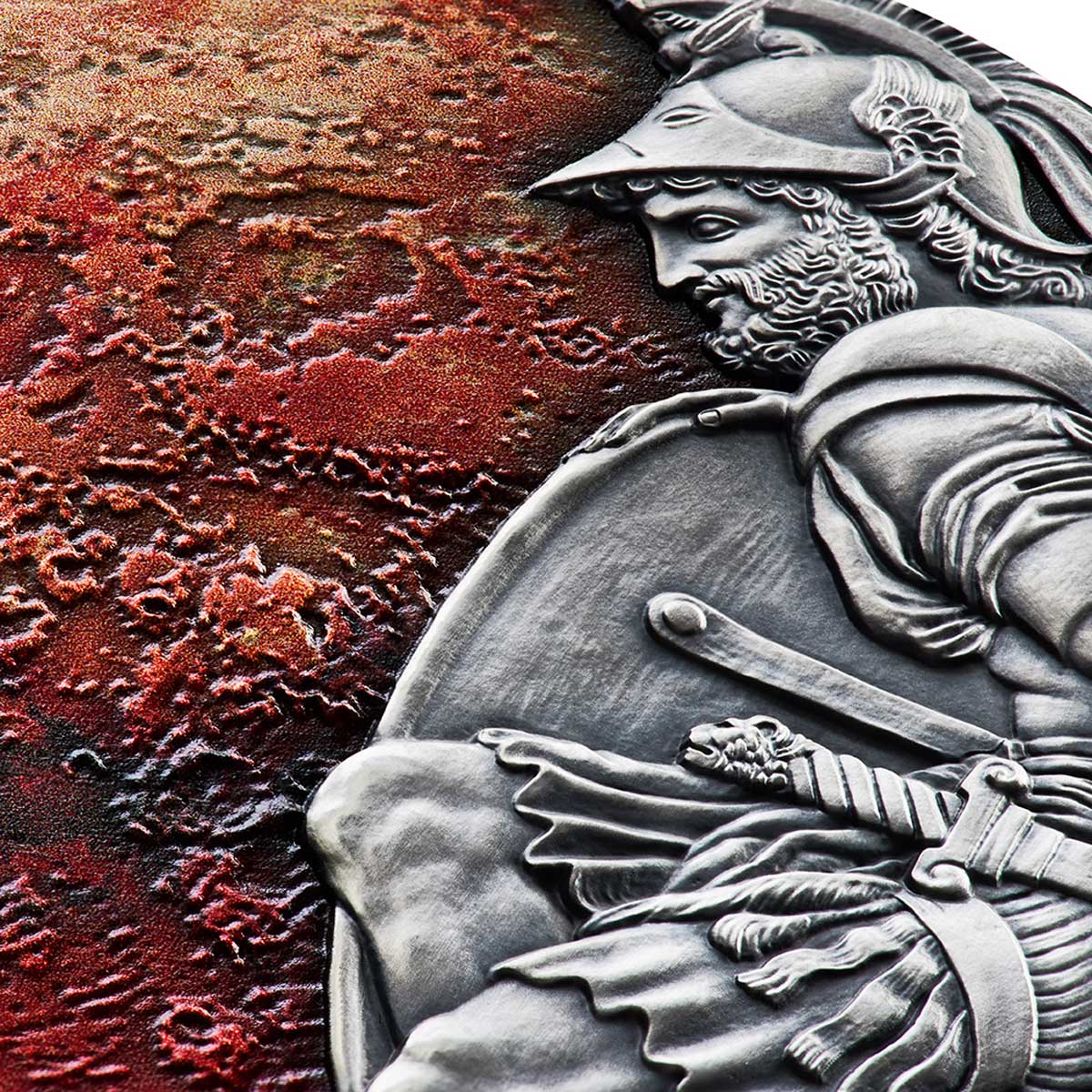
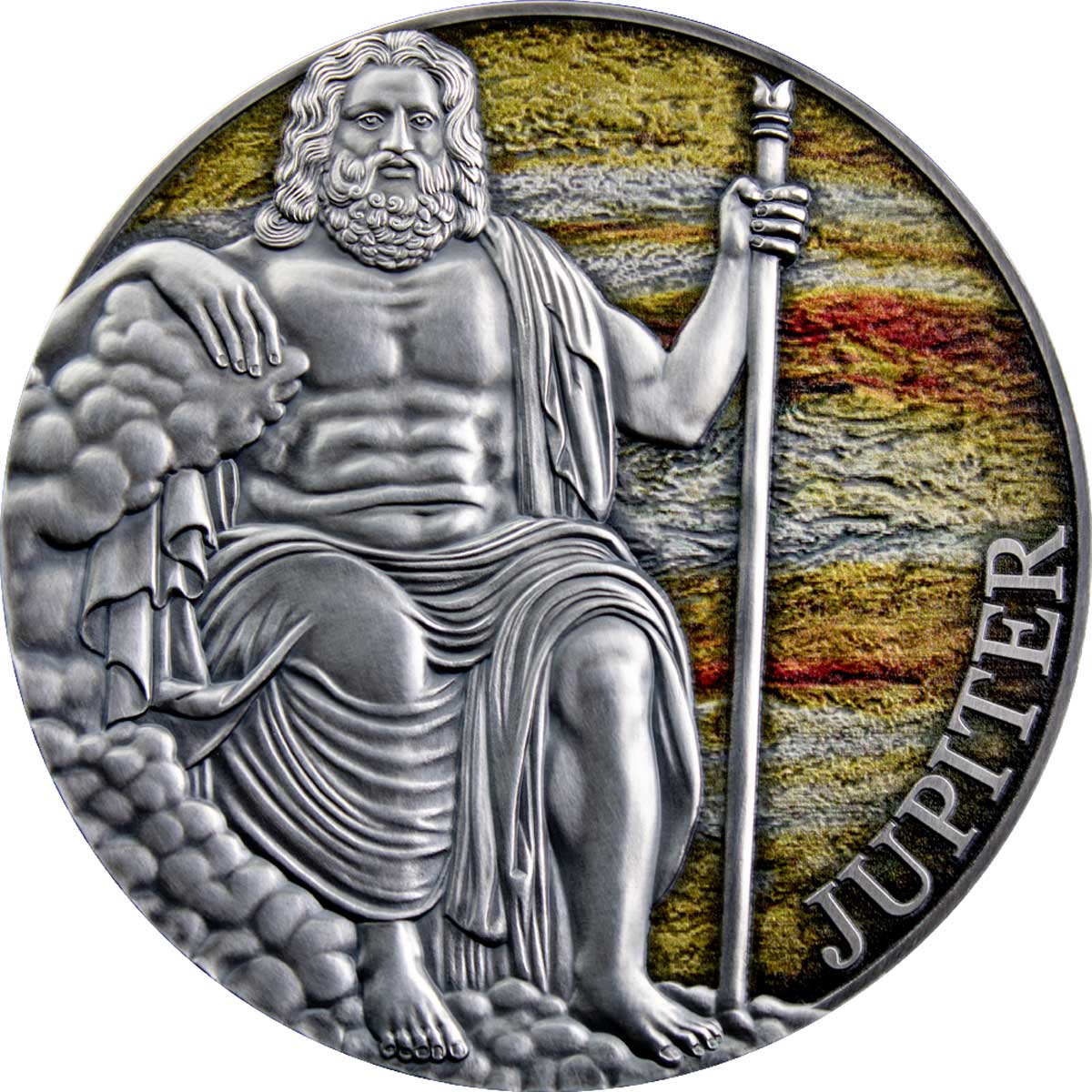
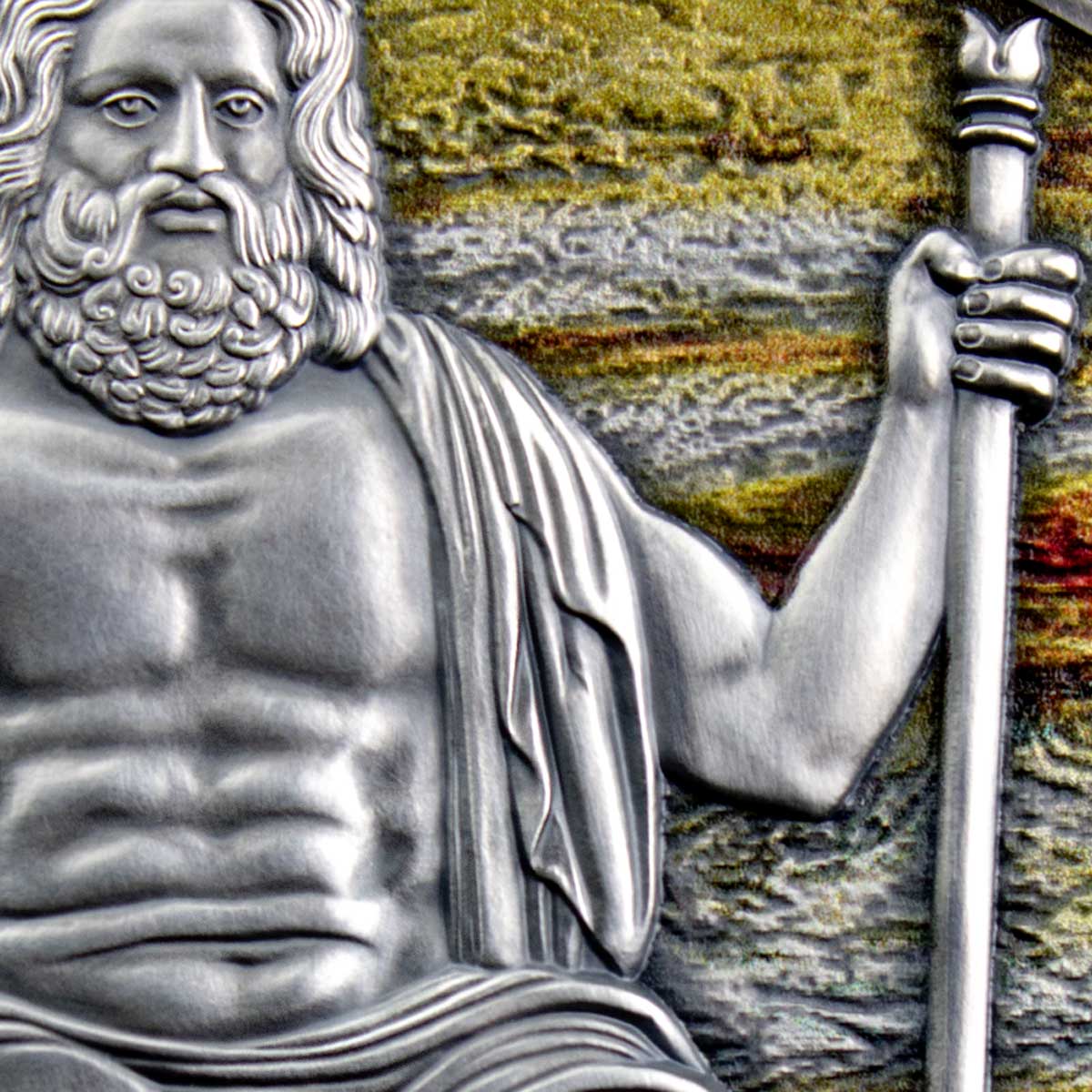
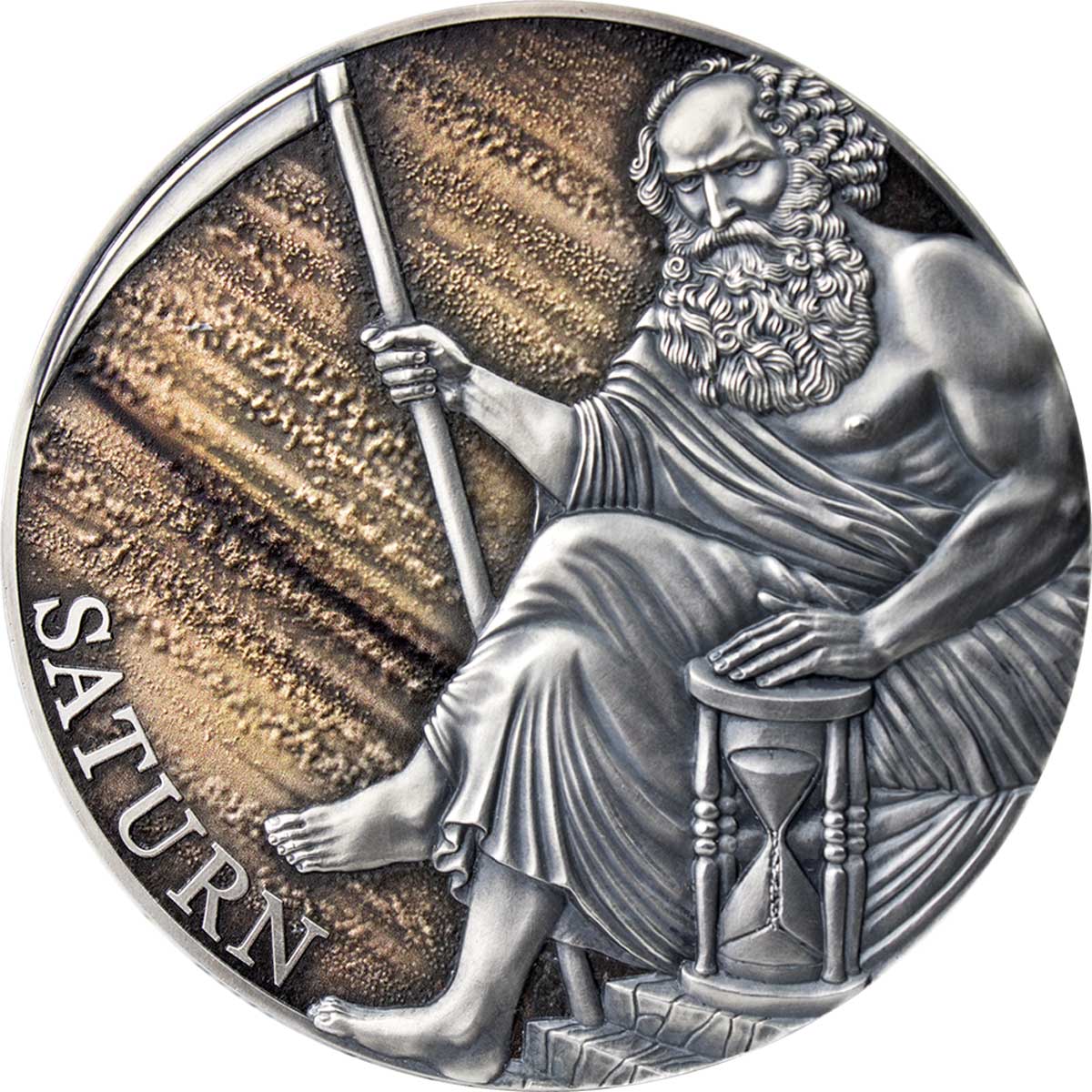
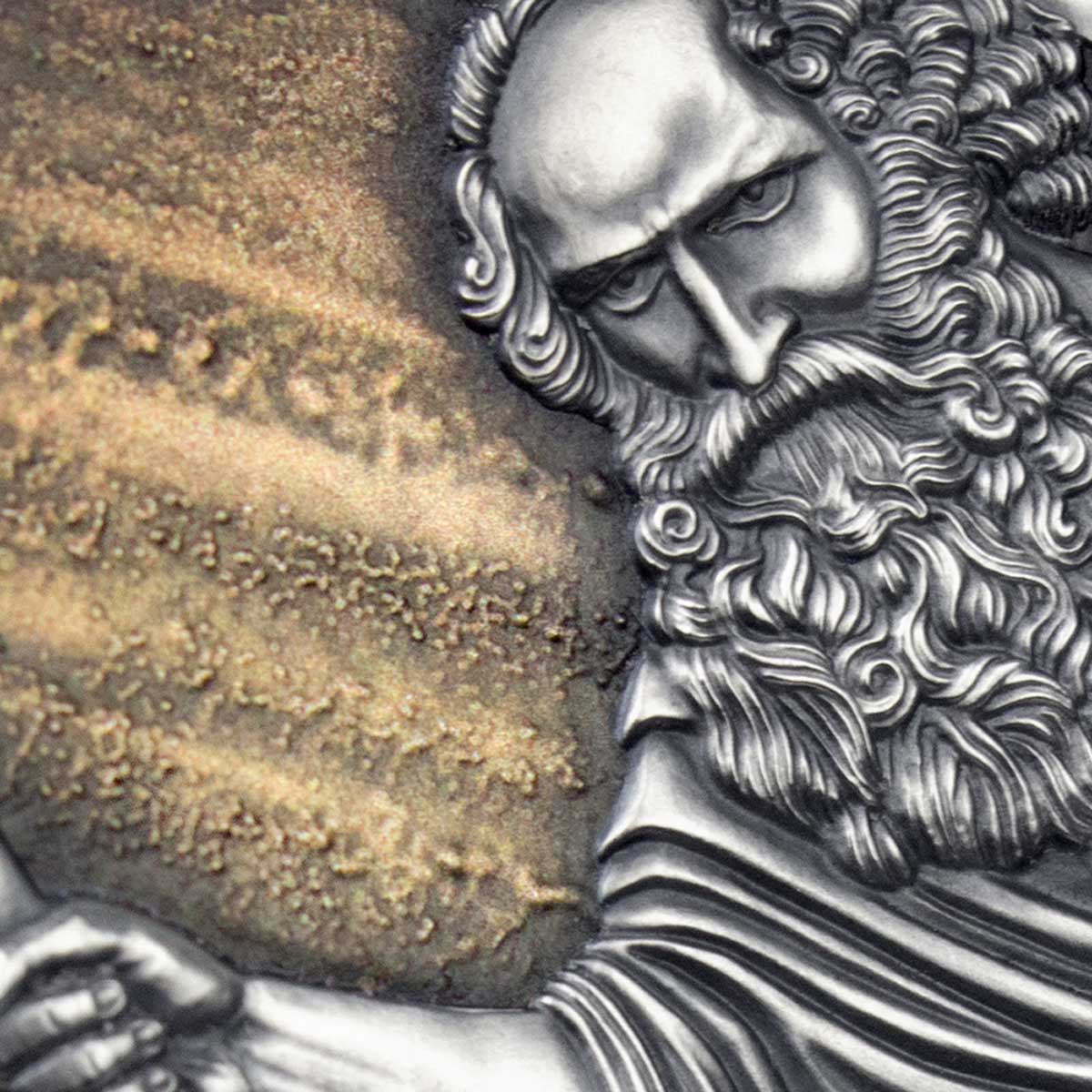

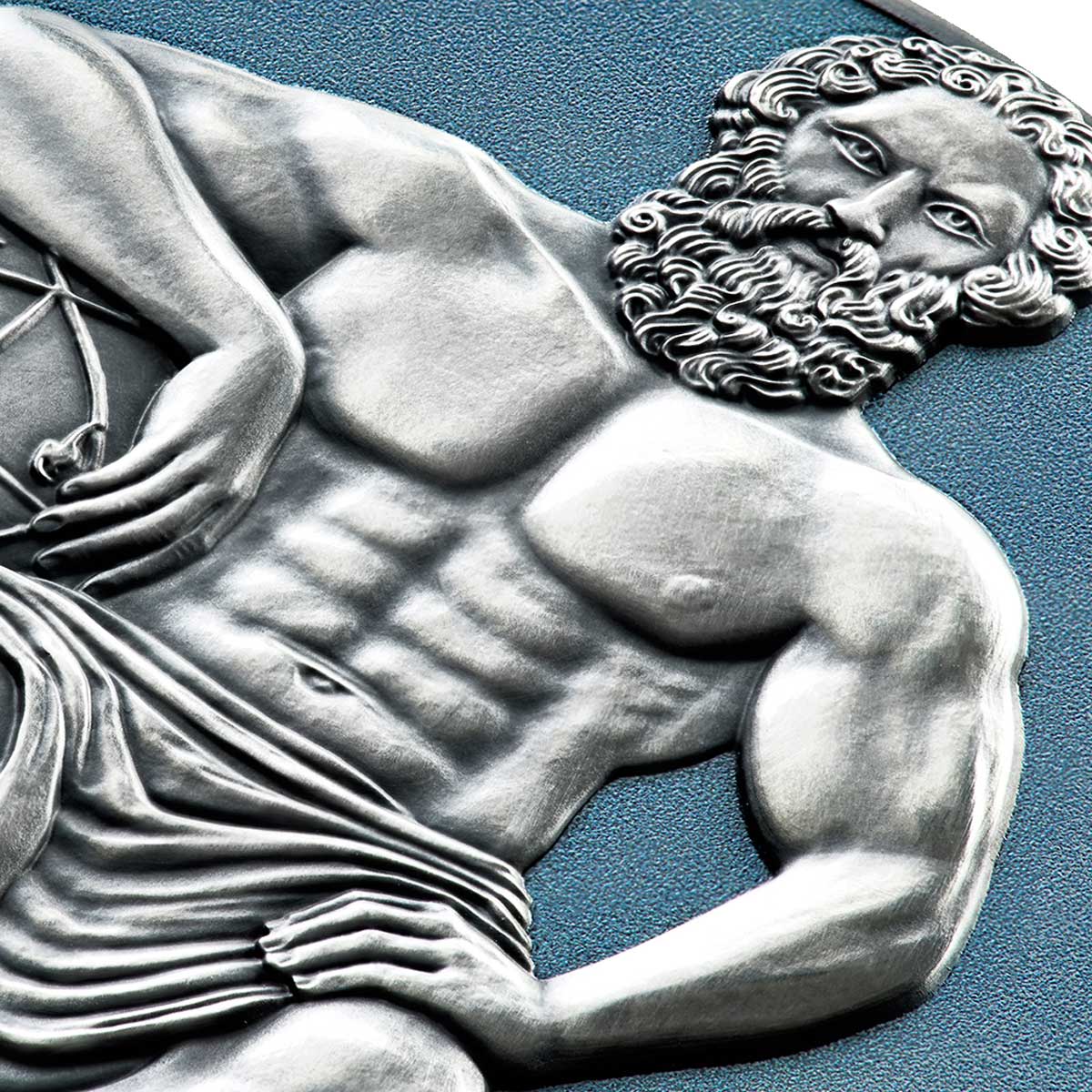




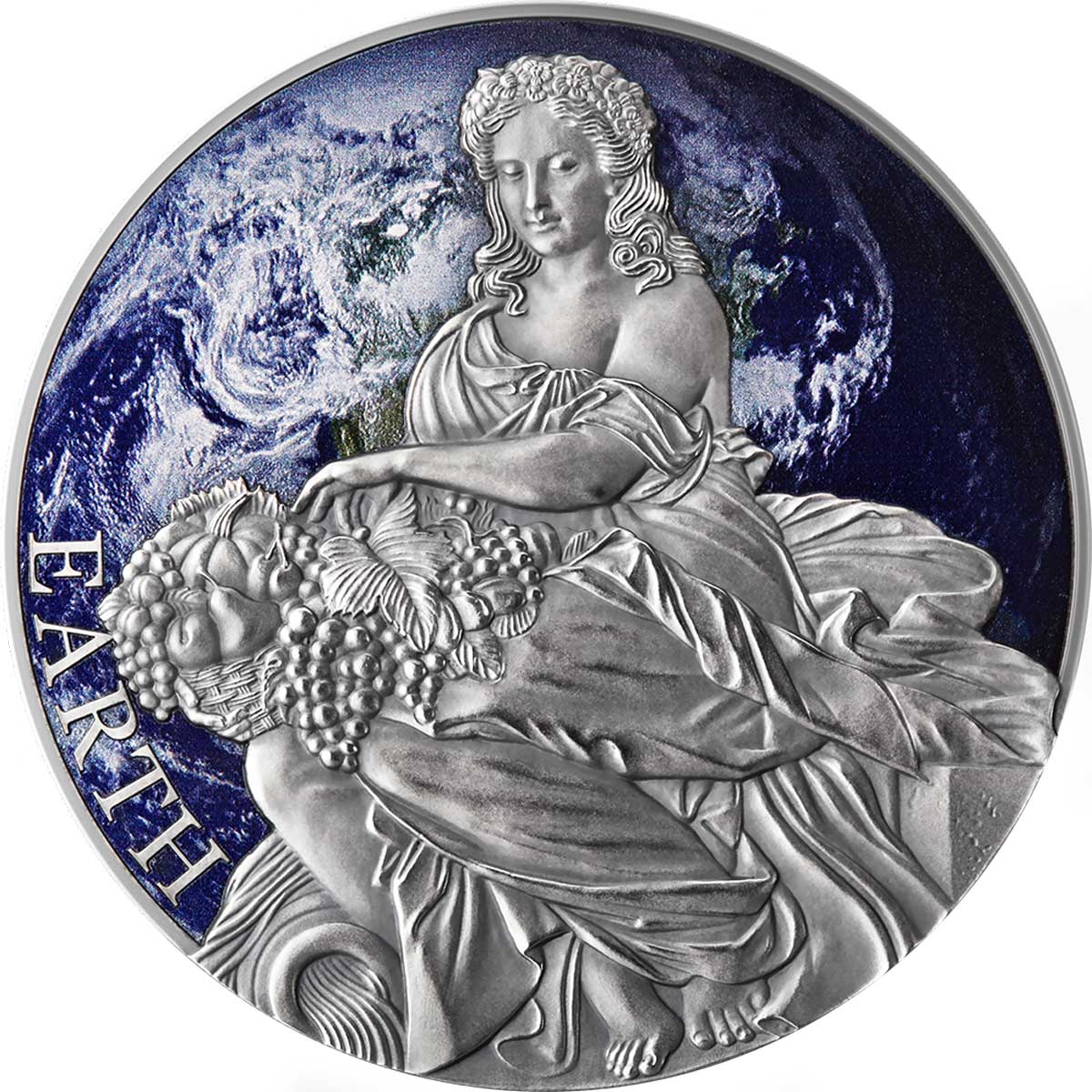
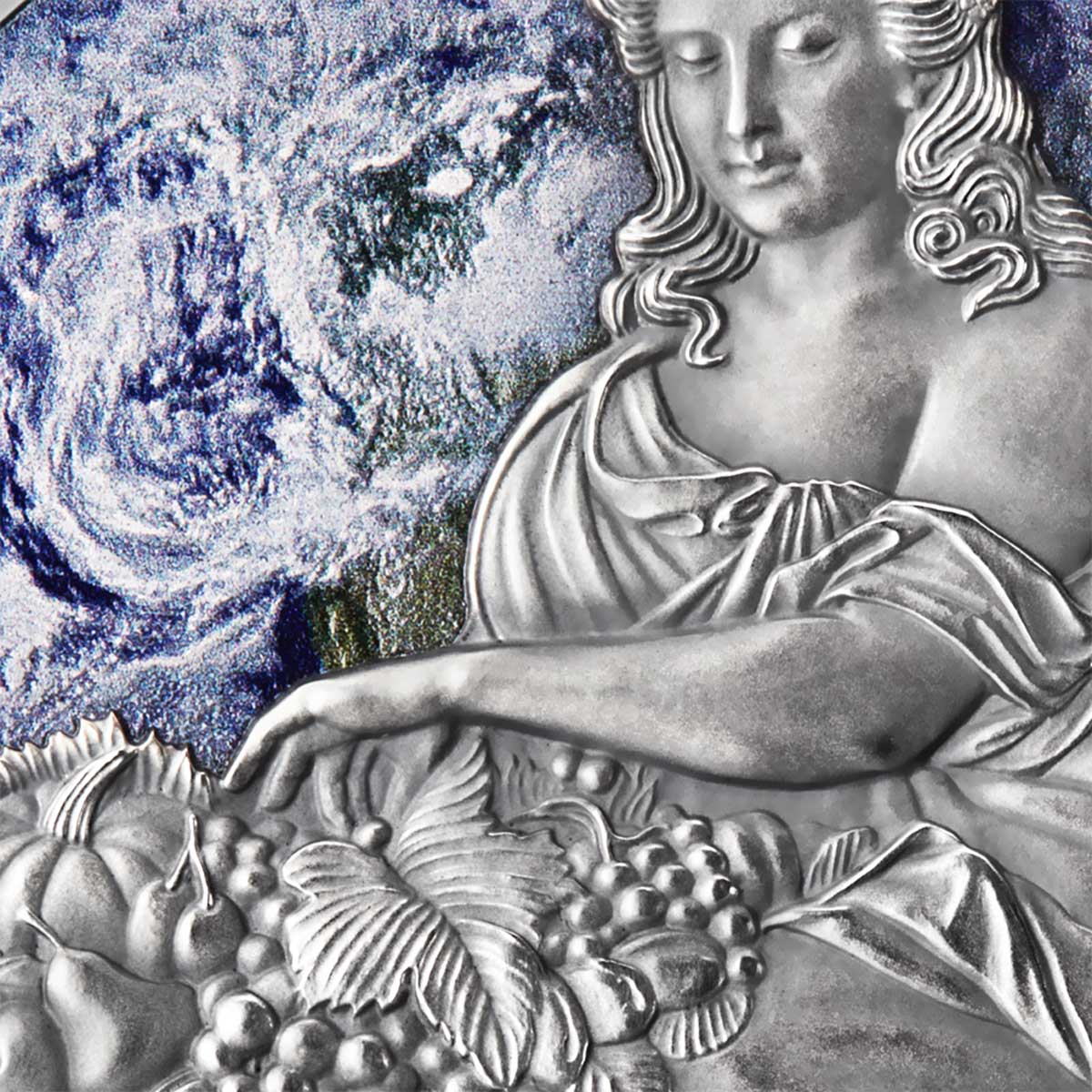
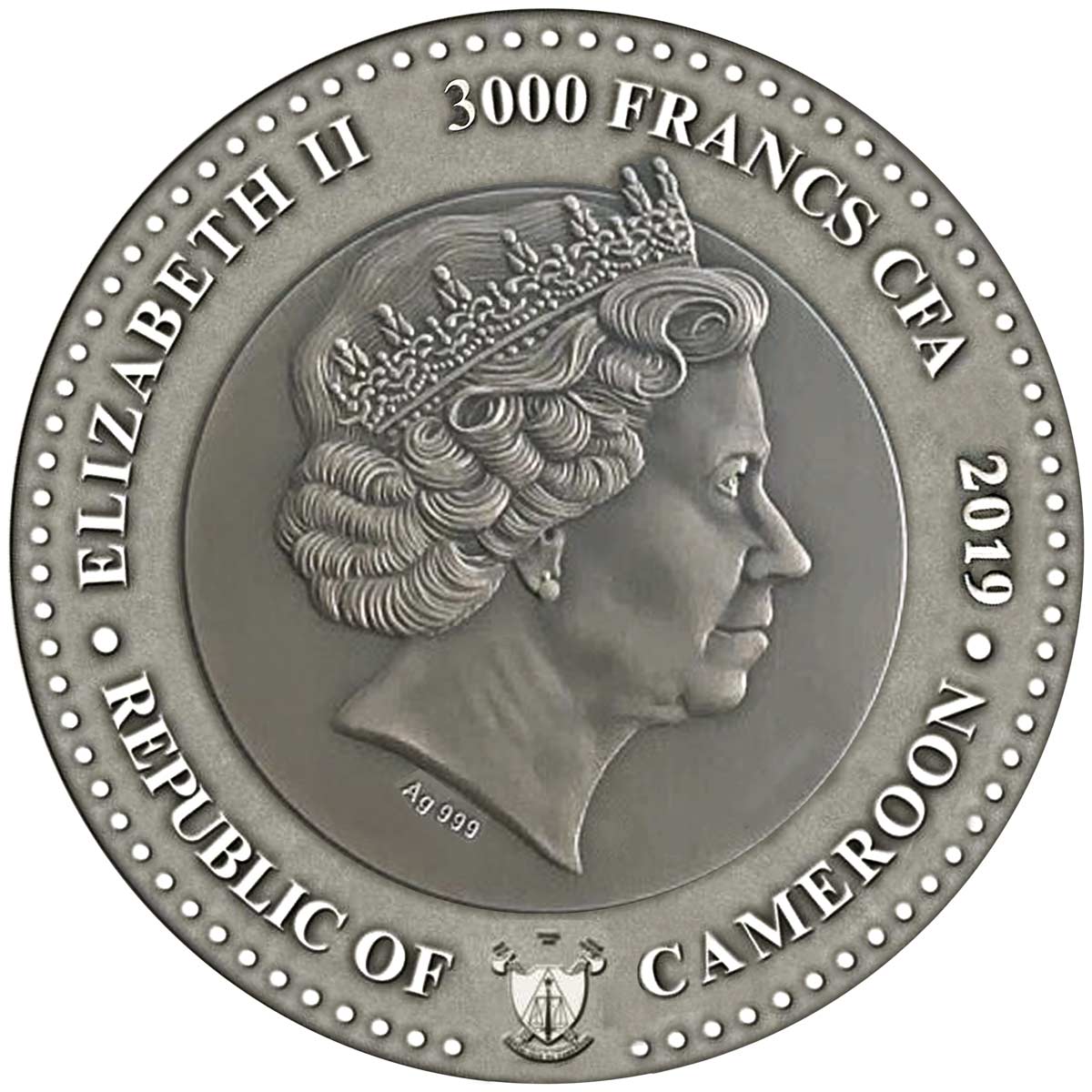
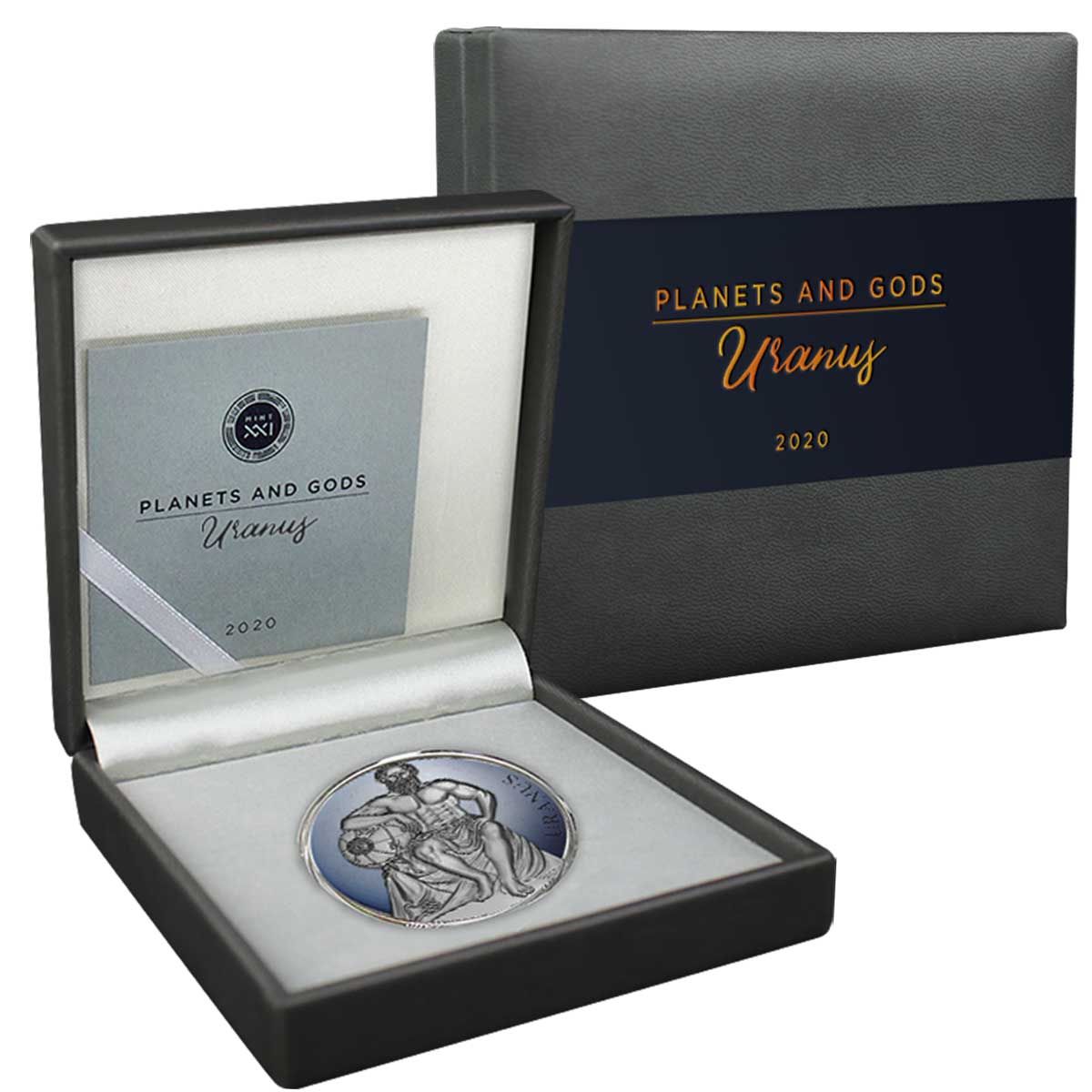
Leave A Comment